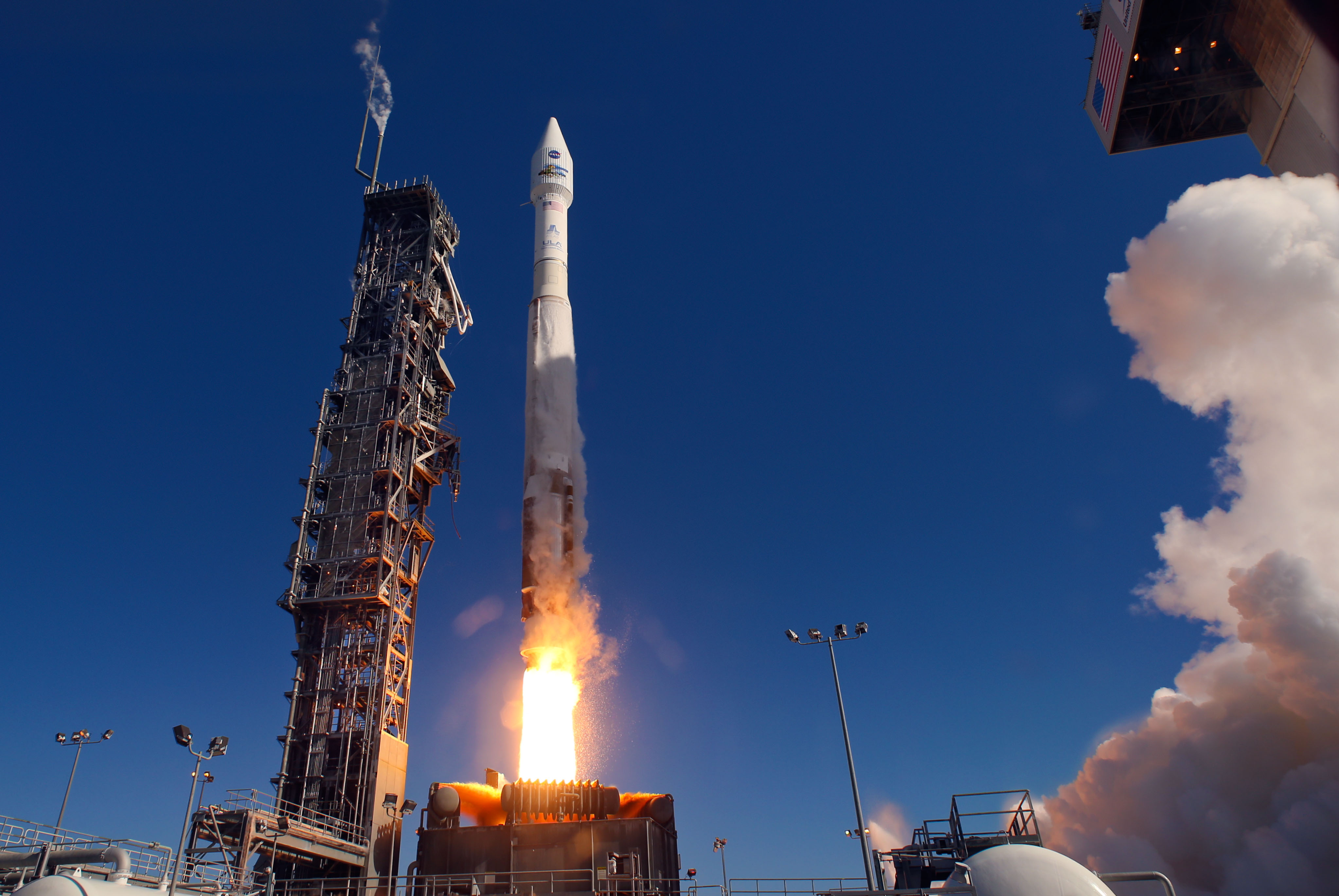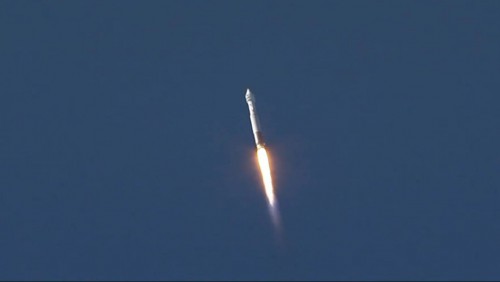
For only the fifth time in its history, United Launch Alliance (ULA) is primed to fly an Atlas V in its “501” configuration Thursday, 5 December, to deliver the classified NROL-39 payload into orbit for the National Reconnaissance Office. This variant of the workhorse launcher—equipped with a 17.7-foot-diameter (5.4-meter) payload fairing, a single-engine Centaur upper stage, and no strap-on rocket boosters—has the capacity to inject payloads weighing up to 17,900 pounds (8,120 kg) into low-Earth orbit and up to 8,320 pounds (3,775 kg) into geostationary transfer orbit, thereby hinting at the substantial nature of NROL-39. Liftoff is scheduled to occur from Space Launch Complex (SLC)-3 at Vandenberg Air Force Base, Calif.With the exception of its name, little of substance is known about NROL-39, and ULA has noted only that its purpose is “in support of national defense.” This mission is the second Atlas to fly from the West Coast in 2013, following February’s launch of the Landsat Data Continuity Mission (LDCM, also known as Landsat-8), and the second Atlas mission in only three weeks, coming hard on the heels of the flight of the Mars Atmosphere and Volatile Evolution (MAVEN) from Cape Canaveral Air Force Station on 18 November. Overall, Thursday’s planned launch will be the 11th flight conducted by ULA this year, from both Vandenberg and the Cape, eight of which have been conducted by the Atlas V and three by the Delta IV. Aside from Landsat-8 and MAVEN, the two rocket families have transported NASA’s latest Tracking and Data Relay Satellite (TDRS-K), two Global Positioning System (GPS) Block IIF satellites, a pair of Wideband Global Satcoms (WGS), a missile early-warning satellite, two military communications satellites, and the classified NROL-65 reconnaissance payload atop the Delta IV Heavy. In spite of these successes, it has been a troubled year for ULA, with the Delta IV officially grounded since October due to ongoing investigations into the RL-10B2 upper stage engine. As noted by Mike Killian in a recent AmericaSpace article, the root of the problem can be traced back to a troubled launch in October 2012. Although the Delta successfully delivered its primary payload into orbit, it became apparent that something had gone awry with the performance. An “unexpected data signature” was identified when the Pratt & Whitney-built RL-10B2 experienced a period of reduced thrust. Fortunately, the vehicle’s robust design, flight software, margins, and propellant reserves enabled it to compensate for this difficulty and complete its mission.

In the wake of the anomaly, ULA and U.S. Air Force experts implemented a number of corrective actions, thoroughly inspecting engine systems for damage or the presence of “foreign objects” and recommended in-flight helium purges of critical components and changes to how the RL-10B2 is thermally conditioned during the early stages of ascent. The commonality of the engine to the RL-10A aboard the Atlas V meant that both rockets were grounded in late 2012, although an Atlas V 501 successfully delivered the third mission of the Air Force’s Orbital Test Vehicle (OTV-3) mini-shuttle into orbit in December. Whilst the Air Force continued with Phase II of its investigation into the engine problems, the Delta IV was finally cleared and returned to flight in May 2013.
However, in mid-October, as final preparations were underway for the launch of the GPS IIF-5 payload aboard a Delta IV, a delay was called. “The ongoing Phase II investigation has included extremely detailed characterization and reconstructions of the instrumentation signatures obtained from the October 2012 launch,” explained ULA spokesperson Jessica Rye, “and these have recently resulted in some updated conclusions related to dynamic responses that occurred on the engine system during the first engine-start event.” The time-critical Atlas V launch of the MAVEN spacecraft on its voyage to Mars in mid-November was apparently unaffected by the problems, and according to Spaceflight Now the Delta IV mission is currently scheduled to fly no earlier than 12 December.
Judging from previous Atlas V pre-flight processing campaigns, the preparations to move the 196-foot-tall (60-meter) vehicle out to the SLC-3 pad should commence about 11 hours ahead of launch, punctuated by detailed weather and payload status checks. The Mobile Launch Platform will depart the giant Vertical Integration Facility (VIF) at T-8 hours and should be “hard-down” on the SLC-3 pad surface within the next hour. This will be followed by a flurry of activity to establish pad connections, perform pneumatic and other checks, and verify the performance of the Atlas’ flight control systems. Status checks will be conducted until relatively late in the count. Two minutes before the scheduled liftoff, the Atlas V will transition to internal power.
In readiness for Thursday’s launch, the booster and payload hardware have been delivered quite literally from points all over the United States and elsewhere in the world. From ULA’s own headquarters in Denver, Colo., to the launch site at Vandenberg Air Force Base, Calif., and from the fabrication of the Centaur upper stage fuel tank in San Diego, to its final assembly in Decatur, Ala., and from the manufacturing of the RD-180 first-stage engine in Khimki, Russia, to the construction of the Atlas V payload fairing in Zurich, Switzerland, this most secretive of launches boasts the distinct flavour of many states and many nations. All of those elements have now converged on Vandenberg to be blasted into orbit.
The Atlas V will fly in its “501” configuration, with a 17.7-foot-diameter (5.4-meter) payload fairing, no strap-on solid-fuelled rocket boosters, and a single-engine Centaur upper stage. Two-and-a-half seconds ahead of liftoff, the first stage’s Russian-built RD-180 engine—with a propulsive yield of 860,000 pounds (390,000 kg)—will roar to life, and climb-out from SLC-3 will occur at T+1.1 seconds. Shortly after clearing the tower, the Atlas will execute a combined pitch, roll, and yaw program maneuver, which will position it onto the proper flight azimuth for the insertion of the classified NROL-39 payload into orbit. Eighty-three seconds into the flight, with the RD-180 still burning hot and hard, the vehicle will burst through the sound barrier. At around this time, the maximum aerodynamic stresses will be felt through the Atlas’ airframe.

Three-and-a-half minutes after launch, the huge, two-piece payload fairing encapsulating NROL-39 will be jettisoned, exposing it to the near-vacuum of space for the first time. The four previous Atlas V 501 payloads have been the three flights of the OTV mini-shuttle—launched from SLC-41 at Cape Canaveral Air Force Station in April 2010, March 2011, and December 2012—and the NROL-41 radar-imaging reconnaissance satellite, which was placed into orbit in September 2010.
The first stage engine will provide the impetus for the first five minutes of the Atlas V’s ascent on Thursday and shortly after being jettisoned the Centaur upper stage—powered by the RL-10 engine, with a total thrust of 25,000 pounds (11,340 kg) in a vacuum—will pick up the baton to push NROL-39 into orbit. The engine has the capacity for multiple restarts, although it remains unclear if Thursday’s mission will require more than a single “burn” to inject its classified payload into the required orbital location.
It has been speculated that NROL-39 may be the third member of the Boeing-built Future Imagery Architecture (FIA) constellation of radar-imaging reconnaissance satellites, due in part to the apparent retrograde nature of its orbit and the 123-degree inclination already revealed by the Atlas V’s secondary payload operators. The FIA was conceived in 1999 as the successor program to the Lacrosse imaging network, which saw five satellites launched—including one from the space shuttle—between 1988 and 2005. Significant cost and schedule overruns forced John Negroponte, then-Director of National Intelligence, to cancel FIA’s optical component in 2005, but the radar element continued under the code name of “Topaz.”
Two FIA satellites have been launched to date: NROL-41 atop an Atlas V 501 in September 2010 and NROL-25 atop a Delta IV Medium+ (5,2) in April 2012, both of which currently reside in circular 680-mile-high (1,100 km) orbits. “This being the second Atlas V 501 launch from Vandenberg,” noted Spaceflight 101 of the impending launch of NROL-39, “it is very likely that it is carrying the next FIA satellite,” adding that “The 123-degree inclination has been confirmed by the secondary payload operators.” Those secondary payload operators are responsible for 12 CubeSats which will also hitch a ride into space aboard the Atlas V and have been provided by the National Reconnaissance Office and through NASA’s Educational Launch of Nanosatellites (ELaNa) program.
Want to keep up-to-date with all things space? Be sure to “Like” AmericaSpace on Facebook and follow us on Twitter: @AmericaSpace
Missions » NROL »



Both photos in this story show a 401 but are labeled and described as a 501. LANDSAT and MAVEN were 401s..